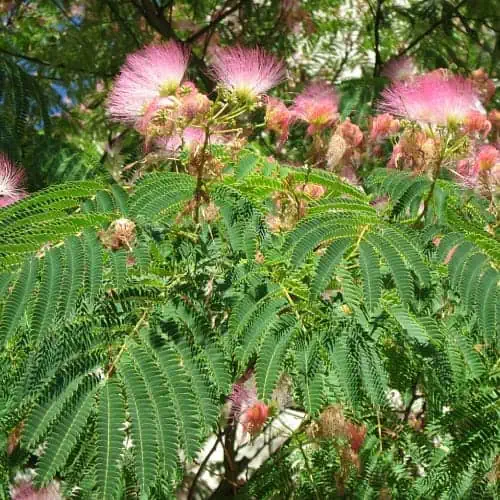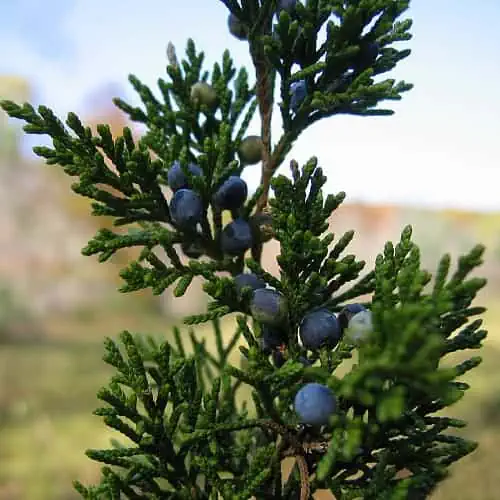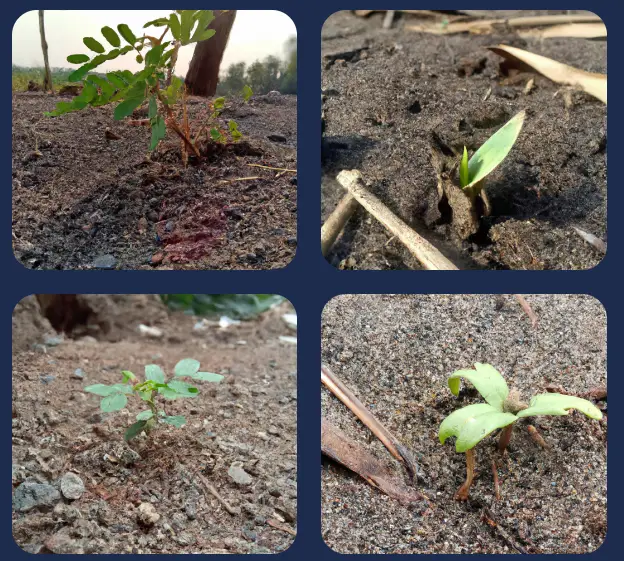Picking trees that will grow well in sandy soil can be no easy task. Despite sandy soil's advantages, such as quick warming in the spring and excellent drainage, it can be a battle to keep enough moisture and nutrients in it. The struggles of sandy soil are significant, but some tree types meet this challenge successfully. Among these hardy species are pines, oaks, and palms. This article will delve into more detail about these trees and offer tips for successful growing in sandy soil.
The key to growing any tree in sandy soil is to amend the soil with organic matter before planting. This will help hold moisture and nutrients in the soil and give your tree a better chance of success. Once your tree is established, make sure to water deeply and regularly during dry periods.
One of the great things about trees is that they can grow in a variety of soil types. This includes sandy soils, which are common in many parts of the world. There are a number of tree species that do well in sandy soils.
These include acacia, eucalyptus, and pines. All of these trees have deep roots that help them to anchor themselves in the loose soil. They also have leaves that are adapted to deal with high levels of salt and wind.
Trees that grow in sandy soil often have to contend with drought conditions. This is why it’s important to choose species that are tolerant of dry conditions. Once established, these trees can provide much-needed shade and shelter from the hot sun and strong winds.
If you have sandy soil in your garden or landscaping, it is important to choose trees that are well-suited for this type of soil. Sandy soil is characterized by its loose, granular texture and poor water retention capabilities. However, there are several types of trees that can thrive in sandy soil and add beauty to your outdoor space.
Overview of sandy soil and its properties
Sandy soil is characterised by its quick water-drainage and lower content of organic matter and nutrients. It drains water swiftly. This characteristic can either be a benefit or a drawback, based on the water requirements of individual plants. Because of its decreased organic and nutrient content, sandy soil is generally less fertile. This distinct nature of sandy soil directly influences plant growth and its fertility. However, compared to other soil types, sandy soil's fertility is relatively lower.
Nevertheless, certain trees have evolved to prosper in sandy soil, showcasing their resilience. Such trees possess deep root systems, enabling them to access the essential moisture and nutrients buried beneath. Not only this, but they are also impressively drought-tolerant.
Such conditions, including sandy soil's fast-draining nature, pose no threat to them. Following this, we delve deeper into the characteristics of these seven specific trees that flourish in such environments. In maintaining a formal tone, let us remember that succinctness and clarity will ensure an engaging read.
Here are seven types of trees that thrive in sandy soil:
- Pine Trees
- Red Maple Trees
- Oak Trees
- Eastern Redcedar Trees
- Sycamore Trees
- Crape Myrtle Trees
- White Birch Trees
These trees not only tolerate sandy soil but also provide shade, and beautiful foliage, and often attract wildlife. They are excellent choices for landscaping projects in areas with sandy soil.
In conclusion, selecting the right trees for sandy soil is crucial for a successful garden or landscaping project. By choosing trees that are adapted to these conditions, you can ensure their healthy growth and enhance the beauty of your outdoor space.

Pine Trees
Features and benefits of pine trees in sandy soil
- Pine trees are well-adapted to sandy soil, as they have long taproots that can reach deep into the ground to access water and nutrients.
- These trees are drought-tolerant, making them ideal for sandy soil, which tends to drain quickly and retain less moisture.
- Pine trees have a dense canopy, providing shade and reducing evaporation from the soil surface.
- The fallen needles of pine trees create a natural mulch, which helps retain moisture in sandy soil.
- The acidic nature of pine needles also lowers the pH of the soil, making it suitable for acid-loving plants.
- Pine trees are resilient and can withstand harsh weather conditions, making them a durable option for sandy soil.
In conclusion, pine trees thrive in sandy soil due to their adaptability to drought, ability to access deep water sources, and their role in improving soil conditions. Planting pine trees in sandy soil can provide multiple benefits such as moisture retention, shade, and creating an environment suitable for other acid-loving plants.

Oak Trees
Characteristics and advantages of oak trees in sandy soil
- Oak trees are known for their deep root systems, allowing them to access water and nutrients even in sandy soil.
- They are highly adaptable and can withstand drought conditions.
- Oak trees provide shade and act as a natural habitat for wildlife.
- The wood of oak trees is durable and highly valued for furniture and construction purposes.
- Oak trees have a long lifespan, often living for several hundred years.
- They require minimal maintenance once established.
- Oak trees provide aesthetic value with their large, spreading canopies.
Compared to other tree types, oak trees have several advantages when planted in sandy soil. Their deep roots make them resilient to drought and allow them to reach water sources deep underground. This makes them perfect for areas with minimal rainfall or sandy soil that tends to drain quickly. Additionally, oak trees can add beauty to any landscape with their distinctive shape and vibrant fall foliage. They are strong and sturdy trees that can withstand storms and high winds. Overall, oak trees are an excellent choice for those looking to create a thriving landscape in sandy soil.

Palm Trees
Suitability and resilience of palm trees in sandy soil
Palm trees are a popular choice for landscaping in areas with sandy soil due to their adaptability and resilience. Here are some key reasons why palm trees thrive in sandy soil:
- Drought Resistance: Palm trees have evolved to survive in arid environments, making them well-suited for sandy soil that drains quickly. They have long taproots that can reach deep water sources, allowing them to withstand periods of drought.
- Salt Tolerance: Sandy soil often contains high levels of salt, which can be detrimental to many other plants. However, palm trees are naturally tolerant of salt, making them a smart choice for coastal areas where salty air and soil prevail.
- Wind Resistance: Sandy soil is prone to erosion, especially in windy conditions. Palm trees have strong root systems that anchor them firmly in the ground, making them stable even in high winds.
- Low Nutrient Requirements: Sandy soil generally lacks essential nutrients, but palm trees are not heavy feeders. They can adapt and thrive with minimal fertilization, which makes them low-maintenance options for sandy landscapes.
- Aesthetically Pleasing: Palm trees add a tropical and exotic touch to any landscape. Their unique shapes and lush foliage create a visually appealing environment, perfect for creating a relaxing and inviting atmosphere.
- Versatile Options: There are numerous types of palm trees that thrive in sandy soil, including the Mediterranean fan palm, saw palmetto, and Sabal palm. These varieties offer various sizes, shapes, and colors, allowing you to choose the perfect palm tree for your landscaping needs.
Overall, palm trees are an excellent choice for sandy soil landscapes due to their ability to tolerate challenging conditions while providing beauty and functionality.

Juniper Trees
Adaptability and beauty of juniper trees in sandy soil
Juniper trees are known for their ability to thrive in various soil conditions, including sandy soil. Here are some key points about the adaptability and beauty of juniper trees in sandy soil:
- Drought Tolerant: Juniper trees have a natural ability to withstand drought conditions, which makes them well-suited for sandy soil that tends to drain water quickly.
- Low Maintenance: These trees are highly adaptable and require minimal maintenance once established in sandy soil. They can tolerate sandy, well-drained soils with ease.
- Beautiful Foliage: Juniper trees offer a range of foliage colors and textures, from blue-green to silvery gray. Their unique shapes and vibrant foliage can add beauty to any landscape.
- Erosion Control: The extensive root system of juniper trees helps stabilize sandy soil, preventing erosion and maintaining the integrity of the landscape.
- Wildlife Habitat: Junipers provide habitat for various bird species and small mammals. Additionally, their berries serve as a food source for wildlife during winter months.
Overall, juniper trees are an excellent choice for landscaping in sandy soil due to their adaptability, low maintenance needs, and aesthetic appeal. Their ability to thrive in such conditions makes them a valuable addition to any garden or natural area.

Sea Grape Trees
Unique qualities and uses of sea grape trees in sandy soil
- Sea Grape trees, also known as Coccoloba uvifera, are native to coastal areas and thrive in sandy soil.
- These trees have large, round leaves that resemble grape leaves, hence their name.
- Sea Grape trees provide excellent shade and are commonly used in landscaping to create beachfront or coastal gardens.
- They are highly adaptable and can withstand strong winds, salt spray, and poor soil conditions.
- In addition to their aesthetic appeal, Sea Grape trees also serve as a natural barrier against erosion, helping to stabilize sand dunes.
- The fruits of Sea Grape trees can be eaten fresh or used to make jam, jelly, or wine. They have a sweet and tart flavor.
- The wood of the Sea Grape tree is dense and durable, making it suitable for crafting furniture or other decorative items.
:max_bytes(150000):strip_icc()/GettyImages-1173162674-ad19c49f81a84ab69c56c015531487a5.jpg)
Crepe Myrtle Trees
Benefits and growth characteristics of crepe myrtle trees in sandy soil
-Crepe myrtle trees (Lagerstroemia) are known for their beautiful blossoms and attractive bark.
-They thrive in sandy soil due to their ability to tolerate drought and poor soil conditions.
-These trees are relatively low maintenance and adapt well to different climates.-Crepe myrtles are resistant to many pests and diseases, making them a resilient choice for sandy soil.-They bloom in various colors, including shades of white, pink, purple, and their small to medium size makes them suitable for smaller landscapes or as focal points in larger gardens.-Crepe myrtle trees are also popular as street trees due to their stunning blooms and resistance to urban conditions.
Overall, crepe myrtle trees are an excellent choice for sandy soil due to their resilience, adaptability, and beautiful blooms. Whether you want to enhance your garden or add color to your street, these trees can thrive in sandy soil conditions.

Eastern Red Cedar Trees
Thriving abilities and uses of eastern red cedar trees in sandy soil
Eastern Red Cedar trees (Juniperus virginiana) are extremely resilient and adaptable, making them an excellent choice for planting in sandy soils. Here are a few reasons why they thrive in sandy soil:
- Drought-tolerant: Eastern Red Cedar trees have a deep root system that allows them to access water even in dry conditions.
- Salt-tolerant: Sandy soils near coastal areas often contain salt, which can be detrimental to many plants. However, Eastern Red Cedars can tolerate high salt levels, making them suitable for seaside landscaping.
- Windbreaks and erosion control: These trees have dense canopy foliage that provides effective windbreaks, helping to reduce wind damage and prevent erosion in sandy soil.
- Wildlife habitat: Eastern Red Cedars produce berries that provide food for birds and small mammals, making them valuable for wildlife conservation.
- Privacy screens: With their dense growth habit and evergreen foliage, these trees are often used to create privacy screens or hedgerows in sandy soil areas.
- Land restoration: Eastern Red Cedars can help restore degraded sandy soils by improving soil structure and preventing erosion.
- Attractive aesthetics: These trees have an attractive pyramidal shape and dark green foliage, adding beauty to sandy soil landscapes.
In summary, Eastern Red Cedar trees thrive in sandy soils due to their drought and salt tolerance, as well as their ability to provide windbreaks, wildlife habitat, privacy screens, and contribute to land restoration efforts.

Can You Plant Trees in Sandy Soil?
Most people think that you need rich, loamy soil to grow trees. However, many species of trees can actually thrive in sandy soils. The key is to choose the right tree for your particular type of sand.
For example, if you have light sand, also known as silica sand, you might want to consider planting pines or firs. These evergreens do well in poor soil because their roots spread wide and anchor them firmly in place. In fact, some types of pines are even tolerant of salt water!
Deciduous trees like maples or oaks will do better if your sand is on the heavier side. Heavy sand holds moisture better than light sand, so these trees won’t suffer from drought as much. Just give them plenty of room to spread their roots; otherwise, they could start leaning and eventually topple over.
Of course, there are always exceptions to the rule. Some fruit trees like apples, need deep, fertile soils in order to produce a good crop. And if you live near the coast, you’ll need to be extra careful about choosing salt-tolerant species since sea air can damage delicate leaves and branches.
In general though, don’t be afraid to experiment with different kinds of trees in your sandy soil. With a little trial and error, you’re sure to find a few that will take root and thrive!
What is the Best Thing to Plant in Sandy Soil?
Sandy soil is one of the most difficult types of soil to work with. It drains quickly and doesn’t hold nutrients well. This makes it hard to grow anything in sandy soil except for a few select plants.
One plant that does well in sandy soil is the succulent Sedum spathulifolium. This plant is native to sandy areas in North America and can tolerate long periods of drought. It has fleshy leaves that store water, allowing it to survive in dry conditions.
The Sedum spathulifolium produces yellow flowers in the summer and can reach up to six inches tall. Another plant that does well in sandy soil is Yucca flaccida. This plant is native to dry regions of the southeastern United States.
It has long, stiff leaves that are resistant to drought and heat. The Yucca flaccida produces white flowers in the spring and can reach up to three feet tall. If you’re looking for grass that will do well in Sandy Soil, consider Bermuda Grass (Cynodon dactylon).
Bermuda Grass is a tough grass that can tolerate hot, dry conditions. It’s often used as turfgrass on golf courses and other lawns because it can withstand heavy foot traffic without damage. Bermuda Grass spreads quickly by rhizomes, so it’s important to keep it trimmed if you don’t want it taking over your garden!
What Evergreens Grow Best in Sandy Soil?
Sandy soil is not ideal for growing most plants, but a few evergreen species thrive in these conditions. One of the best choices for a sandy soil evergreen is the American juniper (Juniperus virginiana). This hardy plant can tolerate drought and salt spray, making it perfect for coastal areas.
Another good option is the eastern red cedar (Juniperus virginiana), which is also tolerant of poor soils and harsh climates. The Leyland cypress (Cupressocyparis leylandii) is another possibility, though it requires more water than the other two options. Whichever evergreen you choose, be sure to give it plenty of room to grow; Sandy soil tends to be very dry and compacted, so your plant will need all the space it can get.
Small Trees That Grow in Sandy Soil
When it comes to finding small trees that will grow in sandy soil, there are a few options available. One option is the dwarf Alberta spruce, which is a slow-growing evergreen tree that can reach up to 6 feet tall. Another option is the American holly, which is an evergreen tree that can also reach up to 6 feet tall and has glossy green leaves.
Finally, the Japanese red maple is a deciduous tree that only grows to be about 15 feet tall but has beautiful reddish-purple leaves.
Fast Growing Trees for Sandy Soil
Sandy soils are one of the most difficult types of soil to grow trees in. They are often very dry and lack the nutrients that trees need to thrive. However, there are a few species of trees that are well-suited for sandy soils.
Here are four of the fastest-growing trees for sandy soil:
1. Red maple (Acer rubrum) Red maples are one of North America’s most popular shade trees.
They grow quickly and can reach 50 feet or more within just a few years. The key to red maple success is planting them in moist, well-drained soil. Sandy soils can be improved by adding compost or other organic matter before planting.
2. Silver maple (Acer saccharinum) Silver maples are another fast-growing tree that does well in sandy soils. They typically reach 40-60 feet within 10-15 years.
Like red maples, silver maples prefer moist, well-drained conditions and will benefit from adding organic matter to sandy soils before planting.
3. Sweetgum (Liquidambar styraciflua) Sweetgums are large deciduous trees that can grow up to 100 feet tall!
They have beautiful fall foliage and produce small, round fruits that attract wildlife like birds and squirrels. Sweetgums perform best in deep, fertile soils but will also do well in sand if amendments are made prior to planting. This tree is not suitable for small yards because it has a very dense root system that can damage sidewalks and driveways if planted too close . . .
Fruit Trees That Grow in Sandy Soil
When it comes to fruit trees that grow in sandy soil, there are quite a few options to choose from. Some of the most popular include:
- Apricot Trees – Apricots are one of the best fruits for growing in sandy soil. They are tolerant of drought and can withstand high temperatures. The only downside is that they require full sun to produce good crops.
- Peach Trees – Peaches also do well in sandy soils. They need full sun and well-drained soil to thrive but can tolerate some drought conditions.
- Plum Trees – Plums are another excellent fruit tree for sandy soil conditions. Like apricots, they require full sun but can handle some heat and dryness.
- Fig Trees – Figs are one of the most heat-tolerant fruit trees and do very well in sandy soils. They need full sun but can also tolerate some drought conditions. 5. Mulberry Trees – Mulberries are an excellent choice for sandy soils as they are often tolerant of drought and saltiness in this type of terrain.
Native Trees for Sandy Soil
Sandy soil can be a challenge to garden in, but certain native trees are well-suited for this environment. Here are a few of the best options:
1. Black oak (Quercus velutina) – This tough tree is native to sandy areas in the eastern United States and can tolerate both dry and poor soils.
It has a deep root system that helps it to withstand drought and strong winds. Black oaks grow slowly but can reach a height of 50-80 feet.
2. American holly (Ilex opaca) – This evergreen tree is another good option for sandy soil. It prefers moist conditions but can also tolerate dryness and salt spray from coastal areas. American hollies can grow up to 40 feet tall and produce small, white flowers in the springtime followed by brightly-colored berries in the fall and winter months.
3. Sweetgum (Liquidambar styraciflua) – Sweet gums are a popular choice for landscaping due to their attractive fall foliage colors, but they also do well in sandy soil.
They have strong roots that help them to resist wind damage and their leaves provide excellent shade during hot summer days.
FAQ (Frequently Asked Questions)
Will these trees require special care in sandy soil?
While these trees are adapted to sandy soil conditions, it is still important to provide proper watering and maintenance to ensure their health and growth.
Can I plant other types of trees in sandy soil?
While these trees are the best options for sandy soil, other trees may also tolerate sandy conditions. However, it is essential to research their specific soil requirements before planting.
Conclusion
Sandy soil is not ideal for most trees, but there are a few species that can thrive in this type of environment. One such tree is the Eastern red cedar, native to North America. This evergreen has deep roots that help it to anchor itself in sandy soil and withstand strong winds.
The Eastern red cedar is also tolerant of drought conditions and salt spray, making it an ideal choice for coastal areas. Other trees that can grow in sandy soil include the American sweetgum, black tupelo, and loblolly pine. While these trees are not as tolerant of drought and salt spray as the Eastern red cedar, they can survive in these conditions if given enough water.



 Dr Ahsanur Rahman, PHD
Dr Ahsanur Rahman, PHD


